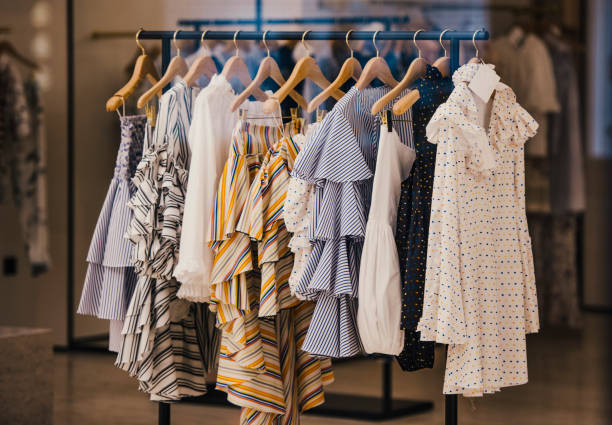The Impact of Social Media on Today's Boutique Fashion Trends
The Impact of Social Media on Today's Boutique Fashion Trends
Blog Article
Checking Out the Advancement and Impact of Garments on Modern Style Trends
The advancement of apparel has actually dramatically affected modern-day style patterns, merging historical precedents with cutting-edge innovations. Iconic numbers like Coco Chanel and Yves Saint Laurent changed the style market by introducing concepts that focus on convenience and availability, which continue to resonate today.
Historic Style Influencers
In the tapestry of fashion background, certain numbers have left an enduring mark, shaping the patterns and designs that define whole eras. Coco Chanel, a cutting edge designer, redefined females's fashion by presenting comfy, sophisticated clothing that departed from limiting corsets.
Elsa Schiaparelli is one more pivotal figure, renowned for her progressive designs that integrated surrealist art, collaborating with Salvador Dalí to produce wayward pieces that challenged standard aesthetic appeals. Her cutting-edge use color and vibrant patterns reverberates in contemporary style. Yves Saint Laurent, meanwhile, democratized haute couture with prêt-à-porter collections, bringing path styles to the masses and setting a precedent for modern-day ready-to-wear lines.
These visionaries, to name a few, not only changed style in their times but likewise established sustaining trends that resonate in today's garment industry, giving a foundation upon which contemporary designers remain to innovate and build. Their heritages highlight the importance of imagination and daring in vogue's ever-evolving narrative.
Technical Innovations in Fashion
Amidst the dynamic landscape of the fashion business, technical developments stand at the leading edge of advancement, improving just how developers produce and customers involve with fashion. The combination of 3D printing has reinvented style processes, allowing designers to try out complex structures and sustainable products that were formerly impossible. This modern technology assists in fast prototyping, minimizing waste and accelerating production times.

Smart fabrics, embedding innovation right into materials, are additionally transforming the market. Innovations like self-cleaning and temperature-regulating textiles provide improved functionality and comfort. Wearable innovation, incorporating features like health and fitness monitoring and communication, adds a brand-new measurement to fashion, merging appearances with practicality.
Social Changes and Design
As technological developments remain to reshape the garment industry, social changes are similarly significant, redefining design and customer choices. In recent times, the surge of social media sites systems has actually increased the circulation of international style fads, permitting varied social impacts to exist together and assemble. This digital interconnectivity has facilitated the rapid exchange of ideas, leading to an extra diverse and comprehensive interpretation of design that mirrors the complex nature of contemporary society.
Cultural awareness and appreciation have actually triggered designers to draw inspiration from a more comprehensive range of ethnic and historical contexts, incorporating conventional motifs with contemporary looks. This combination has actually resulted in fashion that reverberates with a bigger audience, advertising a sense of identity and belonging throughout different demographics. Additionally, the raising need for personalization has driven brand names to provide customizable alternatives, allowing consumers to share uniqueness informative post while reflecting their social heritage.
Furthermore, changing societal worths have actually impacted style, with inclusivity and diversity coming to be central motifs. The market has actually begun to embrace designs and influencers of various type of body, ethnic backgrounds, and sex identities, tough traditional elegance requirements. This transformation highlights the power of social shifts fit the future of fashion, as design becomes a much more genuine expression of personal and cumulative identification.
Sustainability and Modern Design
While the fashion industry continues to develop, the necessary for sustainability has actually come to be significantly immediate, affecting modern-day layout techniques. The surge of slow-moving style, which stresses top quality over amount, urges customers to spend in ageless pieces rather than transient trends.
Furthermore, modern layout is identified by its technology in decreasing waste and advertising circularity. Methods such as zero-waste pattern cutting and 3D knitting are getting traction, allowing designers to develop garments with marginal material waste. Additionally, brands are taking on transparent supply chains, ensuring liability and cultivating consumer trust. This approach not just alleviates environmental impact yet likewise enhances the social duty of style houses.

Future Trends in Fashion

Sustainability a knockout post will certainly continue to be a driving force in forming future fashion fads. The market is increasingly taking on environment-friendly materials and moral production approaches, reacting to an expanding consumer need for accountable practices. Technologies such as bio-fabricated materials and closed-loop recycling systems are readied to redefine exactly how apparel is created and consumed, minimizing environmental effect while maintaining design and top quality.
Cultural changes, including the increase of inclusivity and diversity, will additionally play a critical duty. As society comes to be more conscious of social concerns, fashion is anticipated to become a platform for expression and my website adjustment. Designers will likely focus on developing collections that reflect a wider variety of experiences and identities, promoting depiction and ease of access.
Verdict
The advancement of apparel dramatically impacts modern style fads, where historic impacts combine with modern styles. This ongoing advancement emphasizes fashion's role as a mirror to societal values and technical advancement, suggesting a future rich with advancement and inclusivity.
The evolution of garments has actually significantly affected modern-day style trends, merging historic criteria with innovative advancements.In the middle of the dynamic landscape of the fashion sector, technical developments stand at the forefront of innovation, improving exactly how designers create and customers engage with style.While the style market proceeds to progress, the necessary for sustainability has become significantly urgent, affecting contemporary design techniques. As sustainability ends up being embedded in modern-day style, it leads the method for a more liable and conscious fashion market.
The evolution of apparel considerably influences contemporary style patterns, where historic influences combine with contemporary layouts.
Report this page